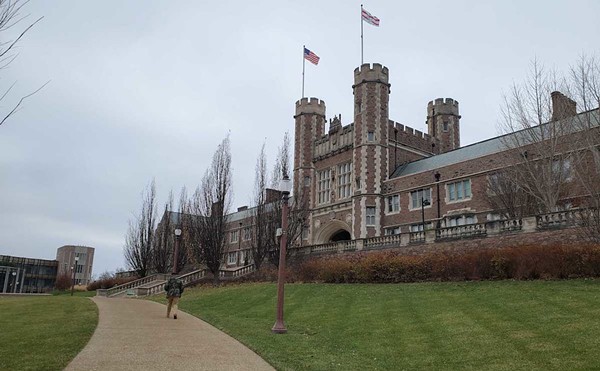"You have a city that's kind of carved out of a forest," says Kuhns, a forestry professor at Utah State University.
The urban forest is part of St. Louis' identity, and that may be one reason why it's so precious. But after the lashing of the storms of 2006, trees are losing their sacred status.
Eastern Missouri's power company, AmerenUE, is already stepping up tree trimming, and state regulators intend to make sure all privately owned electric utilities stay aggressive. New standards for tree trimming are among three rules under consideration at the Missouri Public Service Commission in Jefferson City.
"If you're ever going to do it, now is the time," says Public Service Commission chairman Jeff Davis. "While this is fresh in everyone's mind, you need to go out there and clear-cut those right-of-ways. Right now people are going to be a lot happier to see people out there with chain saws than they are going to be upset about someone cutting limbs."
The storms of July 19 and July 21, 2006, packed winds of 75 miles per hour and left 650,000 customers without electricity, many for as long as nine days. An ice storm on November 30 left 330,000 households without power.
Although AmerenUE's laxness in tree trimming had been an issue in past storms, the Public Service Commission's expert staff concluded in a November 2006 report that no amount of trimming would have prevented the wreckage wrought by the summer's storms.
Nevertheless, Davis says this is an opportune time to improve everyday service. During public hearings after the storms, he notes, "There were a lot of customers that had day-to-day-reliability problems that were not related to the storms. That was something that became apparent to most if not all the commissioners, and it even shocked Ameren a little bit."
AmerenUE has been trying to catch up on its tree trimming since 2004. That year the company agreed to spend $30 million a year in order to get back on track by the end of 2008. In response to the PSC's recent investigation, the company agreed to boost spending to $45 million per year.
The PSC wants utilities to trim trees in urban and suburban areas every four years. Instead of aiming only for limbs that would graze a line on a windy day, Ameren would have to cut any limbs that hang over lines. The company would also be encouraged to talk to customers about potentially hazardous trees that are not on its right-of-way.
To Skip Kincaid, an urban forester who makes his living helping cities and developers preserve trees, this talk is alarming. A tree could lose 30 percent of its canopy to what's called "directional pruning": If the tree is growing under a line, the crew will cut a large V-shaped notch out of the canopy. If it's growing into the line from one side, that side gets buzzed.
Kincaid says trees naturally tend toward a balance between canopy and root growth. "If you throw off that 'root-shoot' ratio, you're going to lose some roots," the forester says. A smaller root base, in turn, weakens the tree.
Cruising around leafy Clayton and University City to point out examples of how zealous trimming would affect the landscape, Kincaid found a 70-foot post oak in a back yard off Forsyth Boulevard. Power lines ran between two abutting properties, with the center of the old oak tree about three feet to the right of the wires.
"The argument now is going to be: 'Should we be taking everything on that left side of the tree off?'" Kincaid says. Then, answering his own question: "Absolutely not."
The post oak has seen some pruning, but most of its characteristically gnarled branches are above the wires. Kincaid says that should not be a concern, because oaks have such strong wood, they aren't likely to splinter in a storm. "Imagine if it's the practice to cut everything off the tree that's over the wire," he says. "It'd be horrible."
Not only would more severe pruning shock a tree that's probably 180 years old, it would probably shock the homeowner, whose backyard afterthought is worth as much as $18,200, by Kincaid's quick calculation.
Kincaid says he's not surprised at the post-storm backlash. After all, the most tree-dense areas seem to have been hit hardest, he says. "Ladue and Frontenac — they got hammered." He notes that at one point the state legislature was eyeing a way to take down hazardous trees outside utility easements.
In a nearby back yard, he pats the trunk of an American elm. The tall specimen doesn't have much canopy left, and Kincaid concedes there's a chance it could fall into the lines at the edge of the yard. "[But] unless you're some kind of whacked-out tree butcher, who in their right mind is going to take down a tree like that?"
The struggle between electric utilities and their customers over trees is age-old. "I can't tell you how many letters I've had over the years," says Ron Zdellar, vice president of energy delivery for AmerenUE. "'I planted that tree when Johnny was born and you've ruined my life.'"
One week before the anniversary of the July 19 storm, AmerenUE announced that it would spend more than $500 million over three years to shore up its system in eastern Missouri, where it serves 1.2 million customers. Much of that money is earmarked for burying lines.
Steve Gaw, the commissioner who spearheaded the creation of the proposed rules, says Ameren's own initiative will not alter the wave of regulation coming from Jefferson City. "The announcement is not something that should derail having standards in Missouri, when clearly we have none," says Gaw.
Two rules — one that would require line, pole and equipment inspections, and a second pertaining to vegetation management — are set for public hearing August 15 in Jefferson City. A third rule would require power companies to document outages at the most-detailed level possible. (Data can be assessed as narrowly as a portion of a subdivision.) That rule might also provide credits to consumers who see frequent or prolonged outages. The controversial proposal is still bouncing around within the commission.
Whatever the new marching orders, customers will end up bearing the financial burden. AmerenUE says complying with the tree-trimming regulations, for example, will cost $184 million a year. The company may seek to recover that expense next time it asks for a rate increase. (Commissioners point out that they don't have to accept the numbers.)
Severe storms often prompt utilities to become more aggressive with maintenance. Leon Daggett, director of Independence Power and Light outside Kansas City, says he used to work for a Kansas City (Kansas) utility that would negotiate with homeowners over how much to trim a given tree.
"After the October 1996 snowstorm and ice storm, we made the decision we weren't going to do that anymore," Daggett recounts. "It made a drastic difference, and it always makes a drastic difference. You have less outages."
Passing through St. Louis, Daggett observes the city's trees living a full, unthreatened life.
"St. Louis loves their trees," he observes. "With all the ice storms and all the problems they've had over the past years, they love their trees."





